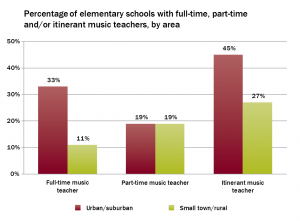Arts education in Ontario’s schools
Arts education plays a vital role in student engagement, achievement, and well-being. It also helps students develop a range of skills and competencies – not just in creativity, but also in citizenship, social-emotional learning, and health.
The province’s renewed vision for education includes a commitment to promote the role of the arts in developing critical and creative thinking skills that support student success. Despite this commitment, there continues to be a lack of specialist teachers in music, visual arts, and drama in elementary schools.
Data from People for Education’s annual report on schools show that in 2016:
- 43% of elementary schools have a music teacher, either full- or part-time, compared to 45% last year. This is the lowest percentage in 10 years and is dramatically lower than in 1998, when 58% of elementary schools had specialist music teachers.
- 38% of elementary schools report having an itinerant music teacher, compared to 39% last year.
- 15% of elementary schools with grades 7 and 8 have specialist visual arts teachers, remaining consistent with last year.
- 9% of elementary schools with grades 7 and 8 have a specialist drama teacher, unchanged in the last two years.
Students in rural/small town schools are at an even greater disadvantage compared to students in urban/suburban schools. Data from the survey shows:
- 52% of elementary schools in urban/suburban areas have a full-time music teacher compared to only 32% of elementary schools in rural/small-town areas.
Data from the report show that students in schools with music teachers – either full- or part-time – are much more likely to have a chance to learn an instrument, work with an artist from outside the school, or participate in a performance.
Read the arts education chapter from the 2016 annual report on schools.

